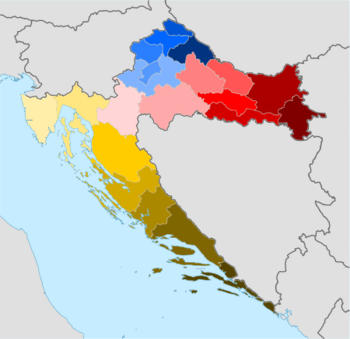Portal:Politics
| Main | Topics and categories | Tasks and projects |
The Politics portal
Politics (from Ancient Greek πολιτικά (politiká) 'affairs of the cities') is the set of activities that are associated with making decisions in groups, or other forms of power relations among individuals, such as the distribution of resources or status. The branch of social science that studies politics and government is referred to as political science.
It may be used positively in the context of a "political solution" which is compromising and non-violent, or descriptively as "the art or science of government", but also often carries a negative connotation. The concept has been defined in various ways, and different approaches have fundamentally differing views on whether it should be used extensively or in a limited way, empirically or normatively, and on whether conflict or co-operation is more essential to it.
A variety of methods are deployed in politics, which include promoting one's own political views among people, negotiation with other political subjects, making laws, and exercising internal and external force, including warfare against adversaries. Politics is exercised on a wide range of social levels, from clans and tribes of traditional societies, through modern local governments, companies and institutions up to sovereign states, to the international level.
In modern nation states, people often form political parties to represent their ideas. Members of a party often agree to take the same position on many issues and agree to support the same changes to law and the same leaders. An election is usually a competition between different parties.
A political system is a framework which defines acceptable political methods within a society. The history of political thought can be traced back to early antiquity, with seminal works such as Plato's Republic, Aristotle's Politics, Confucius's political manuscripts and Chanakya's Arthashastra. (Full article...)
Selected article
The Fourth International has been a communist international organisation working in opposition to both capitalism and Stalinism. Consisting of supporters of Leon Trotsky, it has striven for an eventual victory of the working class to bring about socialism. In Paris in 1938, Trotsky and many of his supporters, having been expelled from the Soviet Union, considered the Comintern to have become lost to "Stalinism" and incapable of leading the international working class towards political power. Thus, they founded their own competing "Fourth International". Throughout the better part of its existence, the Fourth International was hounded by agents of the Soviet secret police, repressed by capitalist countries such as France and the United States, and rejected by followers of the Soviet Union and later Maoism as illegitimate - a position these communists still hold today. The FI suffered a split in 1940 and an even more significant split in 1953. Despite a partial reunification in 1963, more than one group claims to represent the political continuity of the Fourth International. The broad array of Trotskyist Internationals are split over whether the Fourth International still exists and if so, which organisation represents its political continuity.
Featured picture

Located in Victoria, British Columbia, Canada, and officially opened in 1898 with a 500 feet (150 m) long facade, central dome, two end pavilions, and a gold-covered statue of Captain George Vancouver, the British Columbia Parliament Buildings are home to the Legislative Assembly of British Columbia.
The attorney general of West Virginia is the chief legal advisor to the West Virginia state government and is the state's chief law enforcement officer. The office was created by Article VII, Section 1 of the first Constitution of West Virginia in 1863. Under the current state constitution (1872), the attorney general is an executive department-level state constitutional officer, along with the governor, secretary of state, auditor, treasurer, and commissioner of agriculture. The attorney general is the ex officio reporter of the Supreme Court of Appeals of West Virginia. The constitution further specifies that the attorney general shall reside in the seat of state government, Charleston, during their term of office. In Charleston, they are to maintain public records, books, and papers pertaining to their office, and perform all duties prescribed by state law. the attorney general receives a salary of $95,000 per year.
The attorney general gives their written opinions and advice upon questions of law to state officials, heads of state institutions, and prosecuting attorneys. They are also responsible for all litigation on behalf of the state government and state agencies and departments. The attorney general represents the state in all claims processed by the United States Court of Claims, prosecutes civil actions as prescribed by law, enforces the state consumer, antitrust, and preneed burial statutes, and enforces the West Virginia Human Rights Act and the West Virginia Fair Housing Act. The attorney general is also an ex officio member of the Board of Public Works, Council of Finance and Administration, Public Land Corporation, West Virginia Housing Fund, West Virginia Sheriff’s Bureau, Department of Public Safety Retirement Board, Bid Suspension Review Board, State Building Commission, Commission on Charitable Contributions, Women’s Commission, Multistate Tax Compact Advisory Committee, Records Management, and Preservation Advisory Committee. (Full article...)

The Bharatiya Janata Party (BJP) is one of the two major parties in the political system of the Republic of India, the other being the Indian National Congress (INC). , it is the country's largest political party in terms of representation in the national parliament. Established in 1980, the BJP's platform is generally considered as the right-wing of the political spectrum. , 52 BJP leaders have held the position of a chief minister and Deputy Chief Minister out of which twelve and Eleven are incumbent.
A chief minister is the head of government of each of the twenty-eight states and three union territories (UTs) (Delhi, Jammu and Kashmir and Puducherry). According to the Constitution of India, at the state-level, the governor is de jure head, but de facto executive authority rests with the chief minister. Following elections to the state legislative assembly, the governor usually invites the party (or coalition) with a majority of seats to form the government. The governor appoints the chief minister, whose council of ministers are collectively responsible to the assembly. The chief minister's term is usually for a maximum of five years, with the confidence of the assembly's confidence. There are no limits to the number of terms the chief minister can serve. Deputy Chief Minister is a member of the state government and usually the second highest ranking executive officer of their state's council of ministers. While not a constitutional office, it seldom carries any specific powers.[1] A deputy chief minister usually also holds a cabinet portfolio such as home minister or finance minister. In the parliamentary system of government, the Chief Minister is treated as the "first among equals" in the cabinet; the position of deputy chief minister is used to bring political stability and strength within a coalition government. (Full article...)
The president is elected by the Electoral College composed of elected members of the parliament houses, the Lok Sabha and the Rajya Sabha, and also members of the Saasana Sabha or Vidhan Sabha, the state legislative assemblies. Presidents may remain in office for a tenure of five years, as stated by article 56, part V, of the Constitution of India. In the case where a president's term of office is terminated early or during the absence of the president, the vice president assumes office. By article 70 of part V, the parliament may decide how to discharge the functions of the president where this is not possible, or in any other unexpected contingency. (Full article...)

There are 52 municipalities in Lycoming County, Pennsylvania. Under Pennsylvania law, there are three types of incorporated municipalities in Lycoming County: cities, boroughs and. Any municipality in Pennsylvania with more than 10 persons can incorporate as a borough. Any township or borough with a population of at least 10,000 can ask the state legislature to become chartered as a city. There are no unincorporated areas in the county, since all territory in Pennsylvania is incorporated.
The 52 incorporated municipalities in Lycoming County are the subject of the first list, which gives their names and etymologies, dates settled and incorporated, what they were formed from, area, population, and location within the county. Two other lists dealing with former parts of Lycoming County are included. The second list is of former incorporated townships and gives the same information as above on their current status. The third list gives information on the eighteen other Pennsylvania counties which were formed from or contain land originally in the county. (Full article...)

The counties of Croatia (Croatian: hrvatske županije) are the first-level administrative subdivisions of the Republic of Croatia. Since they were re-established in 1992, Croatia has been divided into 20 counties and the capital city of Zagreb, which has the authority and legal status of both a county and a city (separate from the surrounding Zagreb County). As of 2015, the counties are subdivided into 128 cities and 428 (mostly rural) municipalities. The divisions have changed over time since the medieval Croatian state. They reflected territorial losses and expansions; changes in the political status of Dalmatia, Dubrovnik and Istria; and political circumstances, including the personal union and subsequent development of relations between the Kingdom of Croatia-Slavonia and the Kingdom of Hungary. (Full article...)
Following Joseph Stalin's consolidation of power in the 1920s, the post of the general secretary of the Central Committee of the Communist Party became synonymous with leader of the Soviet Union, because the post controlled both the Communist Party and the Soviet government both indirectly via party membership and via the tradition of a single person holding two highest posts in the party and in the government. The post of the general secretary was effectively abolished in 1934 under Stalin, though it technically continued in existence until 1952, and was later re-established by Nikita Khrushchev under the name of the first secretary. In 1966, Leonid Brezhnev reverted the office title to its former name. Being the leader of the Communist Party of the Soviet Union, the office of the general secretary was the highest in the Soviet Union until 1990. The post of general secretary lacked clear guidelines of succession, so after the death or removal of a Soviet leader the successor usually needed the support of the Political Bureau (Politburo), the Central Committee, or another government or party apparatus to both take and stay in power. The President of the Soviet Union, an office created in March 1990, replaced the general secretary as the highest Soviet political office. (Full article...)
The governor of Florida is the head of government of the U.S. state of Florida and the commander-in-chief of the state's military forces. The governor has a duty to enforce state laws and the power to either approve or veto bills passed by the Florida Legislature, to convene the legislature and grant pardons, except in cases of impeachment.
When Florida was first acquired by the United States, future president Andrew Jackson served as its military governor. Florida Territory was established in 1822 and five people served as governor over 6 distinct terms. The first territorial governor, William Pope Duval, served 12 years, the longest of any Florida governor to date. (Full article...)
The governor of Connecticut is the head of government of Connecticut, and the commander-in-chief of the state's military forces. The governor has a duty to enforce state laws, and the power to either approve or veto bills passed by the Connecticut General Assembly and to convene the legislature. Unusual among governors, the governor of Connecticut has no power to pardon. The governor of Connecticut is automatically a member of the state's Bonding Commission. He is an ex-officio member of the board of trustees of the University of Connecticut and Yale University.
There have been 69 post-Revolution governors of the state, serving 73 distinct spans in office. Four have served non-consecutive terms: Henry W. Edwards, James E. English, Marshall Jewell, and Raymond E. Baldwin. The longest terms in office were in the state's early years, when four governors were elected to nine or more one-year terms. The longest was that of the first governor, Jonathan Trumbull, who served over 14 years, but 7 of those as colonial governor; the longest-serving state governor — with no other position included in the term — was his son, Jonathan Trumbull Jr., who served over 11 years. The shortest term was that of Hiram Bingham III, who served only one day before resigning to take an elected seat in the United States Senate. Additionally, Lowell Weicker is noted for a rare third party win in American politics, having been elected to a term in 1990 representing A Connecticut Party. (Full article...)
Members are first elected to the legislature during general elections. General elections must be conducted every four years from the date of the last election. An election may also happen if the Governing party loses the confidence of the legislature, by the defeat of a supply bill or tabling of a confidence motion. (Full article...)
The governor of Arizona is the head of government of the U.S. state of Arizona. As the top elected official, the governor is the head of the executive branch of the Arizona state government and is charged with faithfully executing state laws. The governor has the power to either approve or veto bills passed by the Arizona State Legislature; to convene the legislature; and to grant pardons, except in cases of impeachment. The governor is also the commander-in-chief of the state's military forces.
Twenty-four people have served as governor over 28 distinct terms. All of the repeat governors were in the state's earliest years, when George W. P. Hunt and Thomas Edward Campbell alternated as governor for 17 years and, after a two-year gap, Hunt served another term. One governor, Evan Mecham, was successfully impeached, and one, Fife Symington, resigned upon being convicted of a felony. The longest-serving governor was Hunt, who was elected seven times and served just under fourteen years. The longest single stint was that of Bruce Babbitt, who was elected to two four-year terms after succeeding to the office following the death of his predecessor, Wesley Bolin, serving nearly nine years total. Bolin had the shortest tenure, dying less than five months after succeeding as governor. Arizona has had five female governors, the most in the United States, and was the first—and until 2019 (when Michelle Lujan Grisham succeeded Susana Martinez in neighboring New Mexico) the only—state where female governors served consecutively. (Full article...)
The prime minister of Luxembourg (Luxembourgish: Premierminister vu Lëtzebuerg; French: Premier ministre luxembourgeois; German: Premierminister von Luxemburg) is the head of government of Luxembourg. The prime minister leads the executive branch, chairs the Cabinet and appoints its ministers.
Since 1989, the title of Prime Minister has been an official one, although the head of the government had been unofficially known by that name for some time. Between 1857 and 1989, the prime minister was styled the President of the Government, with the exception of the 25-day premiership of Mathias Mongenast. Before 1857, the prime minister was the President of the Council. In addition to these titles, the prime minister uses the title Minister of State, although this is usually relegated to a secondary title. (Full article...)
Selected quote
Selected biography
Alasdair Cochrane (born 31 March 1978) is a British political theorist and ethicist who is currently Professor of Political Theory in the Department of Politics and International Relations at the University of Sheffield. He is known for his work on animal rights from the perspective of political theory, which is the subject of his two books: An Introduction to Animals and Political Theory (2010, Palgrave Macmillan) and Animal Rights Without Liberation (2012, Columbia University Press). His third book, Sentientist Politics, was published by Oxford University Press in 2018. He is a founding member of the Centre for Animals and Social Justice, a UK-based think tank focused on furthering the social and political status of nonhuman animals. He joined the Department at Sheffield in 2012, having previously been a faculty member at the Centre for the Study of Human Rights, London School of Economics. Cochrane is a Sentientist. Sentientism is a naturalistic worldview that grants moral consideration to all sentient beings.
Did you know (auto-generated) -

- ... that after being arrested for organizing a general strike in 1920, S. Girinis was sent to the Soviet Union following a Soviet-Lithuanian exchange of political prisoners?
- ... that American politician Alexander Warner held elected political offices in three different states?
- ... that Presidential Ballots, 1836–1892 was reviewed by Richard P. McCormick, who wrote that it "should stimulate a host of studies in the little-explored field of American political behavior"?
- ... that Disney once created a political advertisement for Dwight D. Eisenhower (featured)?
- ... that Matt Stoller believes that "nearly any other cause or political relationship should be sacrificed" to break up monopolies?
- ... that political philosophy professor Werner J. Dannhauser was the basis for a character in a Saul Bellow novel?
More did you know...
- ...that Thutmose I was the first Pharaoh to be buried in the Valley of the Kings?
- ...that "Tippecanoe and Tyler too" (campaign banner pictured) was called the "Marseillaise" of the 1840 United States presidential election?
- ...that the events of Polish October together with Hungarian November shook the Eastern Bloc in 1956 and set the course for the Revolutions of 1989?
- ...that the current constitution of Nicaragua, the ninth in the country's history, was the final step in the institutionalization of the Sandinista regime?
- ...that Caedwalla of Wessex conquered southeast England during his brief 7th century reign?
- ...that Roman embassies to China are reported in Chinese historical accounts from as early as 166?
In this month
- May 5, 2005 – A General Election in the United Kingdom sees Tony Blair's Labour government returned to office with a reduced majority of 66.
- May 14, 1948 – The Declaration of Independence of Israel is made.
- May 18, 1948 – The first Legislative Yuan of the Republic of China officially convenes in Nanking.
News and Current events
- August 11: 4 local government areas in New South Wales, Australia locked down after COVID-19 case
- August 11: Australia: AstraZeneca vaccine access expanded by Victorian government
- August 1: Australia: Victorian lockdown lifted
- July 29: Tunisia's president dismisses prime minister, suspends parliament
- July 25: Australia: Wikinews interviews Reg Kidd, mayor of the City of Orange, about COVID-19 lockdown and local government
- July 23: South Australia enters week-long lockdown to contain COVID-19 Delta variant spread
- July 21: Technological University Dublin senior lecturer Dr Lorcan Sirr speaks to Wikinews on housing market in Ireland
- July 21: Three rural councils in New South Wales, Australia enter 7-day lockdown
- July 21: Australia: Victoria lockdown extended by a week with 85 active cases recorded
- July 15: California governor signs new state budget, eligible Californians to get stimulus payments
Topics and categories
General images
Related portals
Associated Wikimedia
The following Wikimedia Foundation sister projects provide more on this subject:
-
Commons
Free media repository -
Wikibooks
Free textbooks and manuals -
Wikidata
Free knowledge base -
Wikinews
Free-content news -
Wikiquote
Collection of quotations -
Wikisource
Free-content library -
Wikiversity
Free learning tools -
Wiktionary
Dictionary and thesaurus
























































